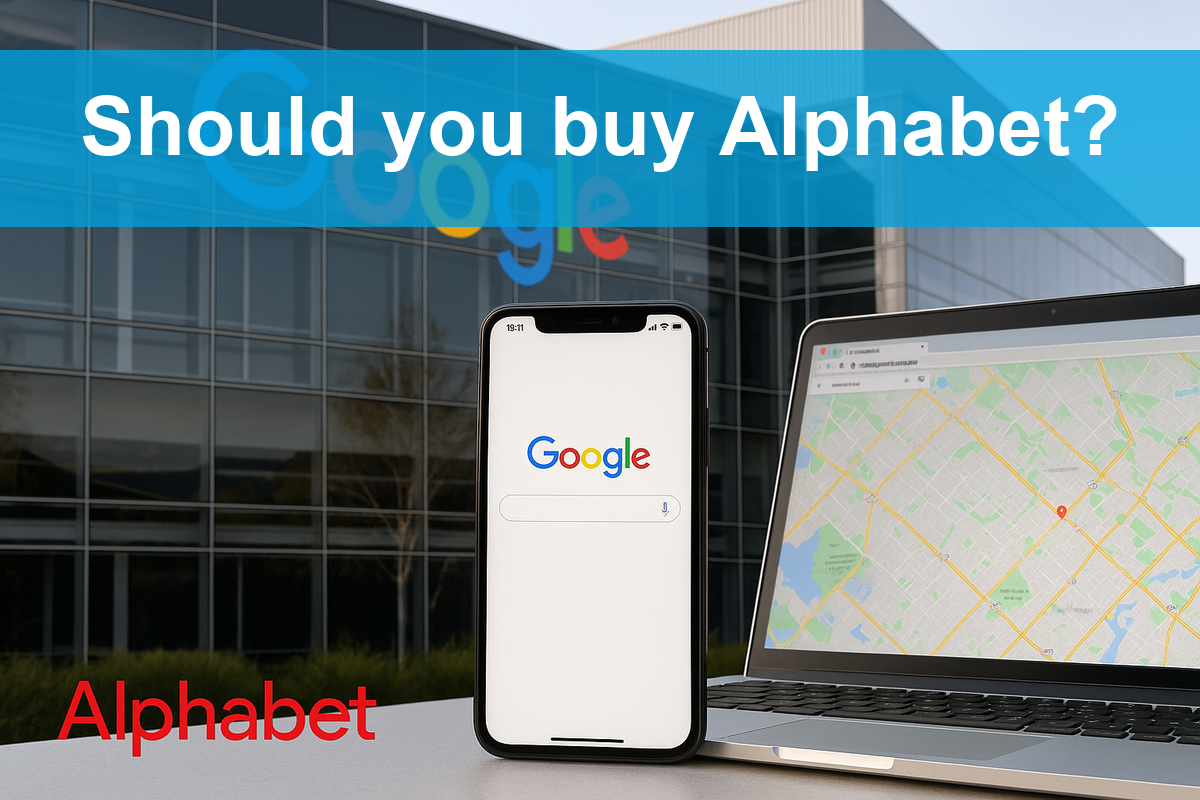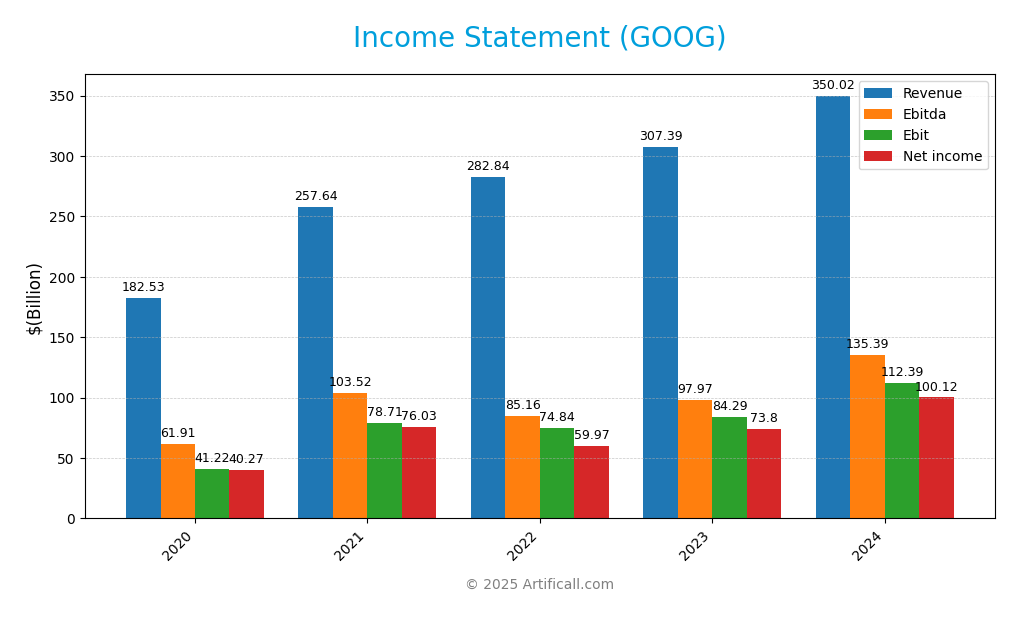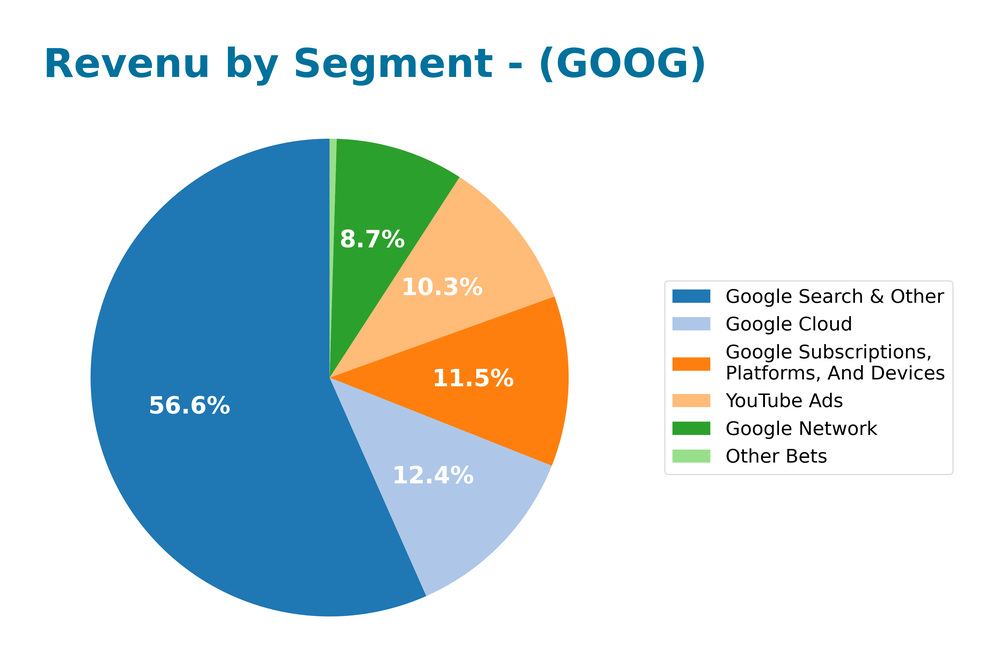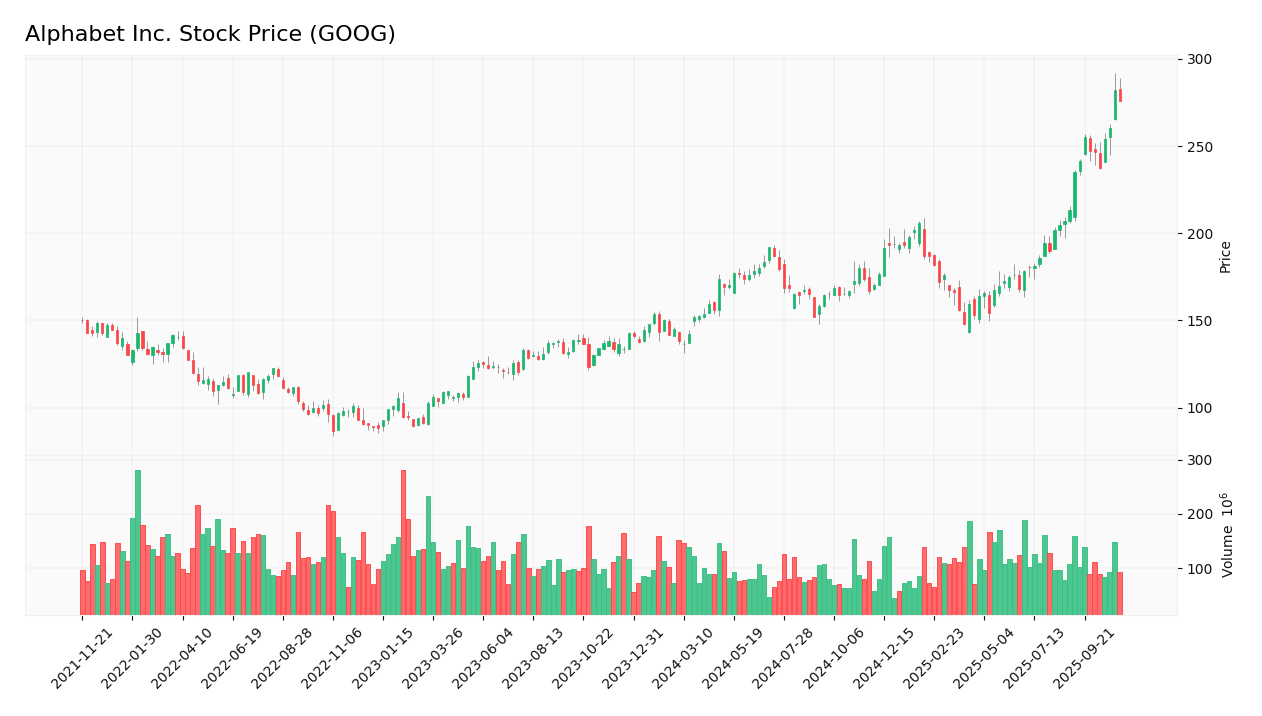Every day, Alphabet Inc. weaves itself into the fabric of our lives, shaping how we access information and connect with the world. As a titan in the Internet Content & Information sector, Alphabet drives innovation through its flagship offerings like Google Search, YouTube, and Google Cloud, consistently setting benchmarks for reliability and quality. With a market cap surpassing $3.9T, the question now is whether Alphabet’s robust fundamentals continue to support its lofty valuation and growth trajectory in an ever-evolving digital landscape.

Table of contents
Company Description
Alphabet Inc. is a leading technology conglomerate founded in 1998 and headquartered in Mountain View, California. The company operates primarily through three segments: Google Services, Google Cloud, and Other Bets. Its core offerings include widely used products such as Google Search, YouTube, Android, and Google Workspace, catering to a global market across North America, Europe, and Asia-Pacific. With a market capitalization of approximately 3.92T, Alphabet stands as a dominant player in the Internet Content & Information industry. The company is recognized for its innovative approach, particularly in artificial intelligence and cloud computing, solidifying its strategic position as a major influencer in shaping the digital landscape and driving technological advancements.
Fundamental Analysis
In this section, I will conduct a fundamental analysis of Alphabet Inc., covering the income statement, financial ratios, and dividend payout policy.
Income Statement
The following table presents the income statement for Alphabet Inc. (GOOG) over the past five fiscal years, highlighting key financial figures crucial for evaluating the company’s performance.

| Item | 2020 | 2021 | 2022 | 2023 | 2024 |
|---|---|---|---|---|---|
| Revenue | 182.5B | 257.6B | 282.8B | 307.4B | 350.0B |
| Cost of Revenue | 84.7B | 110.9B | 126.2B | 133.3B | 146.3B |
| Operating Expenses | 56.6B | 67.9B | 81.8B | 89.8B | 91.3B |
| Gross Profit | 97.8B | 146.7B | 156.6B | 174.1B | 203.7B |
| EBITDA | 61.9B | 103.5B | 85.2B | 97.9B | 135.4B |
| EBIT | 48.2B | 91.1B | 71.7B | 86.0B | 120.1B |
| Interest Expense | 0.135B | 0.346B | 0.357B | 0.308B | 0.268B |
| Net Income | 40.3B | 76.0B | 59.9B | 73.8B | 100.1B |
| EPS | 2.96 | 5.69 | 4.59 | 5.84 | 8.13 |
| Filing Date | 2021-02-03 | 2022-02-02 | 2023-02-03 | 2024-01-31 | 2025-02-05 |
Interpretation of Income Statement
Over the past five years, Alphabet Inc. has consistently increased its revenue, growing from 182.5B in 2020 to 350.0B in 2024, reflecting a robust 92% increase. Net income has shown a similar trend, rising from 40.3B to 100.1B, indicating strong profitability. The gross profit margin has improved, suggesting effective cost management as operating expenses have only slightly increased. In 2024, the company achieved an impressive EBITDA of 135.4B, marking a significant recovery and growth in margins following the previous year. This performance is indicative of its strong market position and operational efficiency, despite a competitive landscape.
Financial Ratios
Below is the financial ratios table for Alphabet Inc. (GOOG) over the last few fiscal years.
| Ratios | 2021 | 2022 | 2023 | 2024 |
|---|---|---|---|---|
| Net Margin | 29.51% | 21.20% | 24.01% | 28.60% |
| ROE | 30.22% | 23.41% | 26.04% | 30.80% |
| ROIC | 22.19% | 21.09% | 22.44% | 25.80% |
| P/E | 25.44 | 19.22 | 23.91 | 23.29 |
| P/B | 7.69 | 4.50 | 6.23 | 7.17 |
| Current Ratio | 2.93 | 2.38 | 2.10 | 1.84 |
| Quick Ratio | 2.91 | 2.34 | 2.10 | 1.84 |
| D/E | 0.11 | 0.12 | 0.10 | 0.06 |
| Debt-to-Assets | 8.30% | 8.13% | 6.74% | 5.65% |
| Interest Coverage | 227.50 | 209.64 | 273.68 | 419.37 |
| Asset Turnover | 0.72 | 0.77 | 0.76 | 0.78 |
| Fixed Asset Turnover | 2.33 | 2.23 | 2.07 | 1.90 |
| Dividend Yield | 0% | 0% | 0% | 0.32% |
Interpretation of Financial Ratios
Analyzing Alphabet Inc.’s financial ratios reveals a generally robust financial health. The liquidity position is strong, with a current ratio of 1.84 and a quick ratio of 1.84, indicating ample short-term assets to cover liabilities. The solvency ratio stands at 0.92, reflecting low debt levels (debt-to-equity ratio of 0.08), which is favorable. Profitability metrics are promising, with a net profit margin of 28.6% and an impressive return on equity of 30.8%. However, the price-to-earnings ratio of 23.3 suggests the stock might be slightly overvalued relative to earnings. Additionally, the cash ratio of 0.26 raises some concern about immediate liquidity, indicating that while the company is stable, there could be challenges in covering short-term obligations without liquidating assets.
Evolution of Financial Ratios
Over the past five years, Alphabet Inc.’s financial ratios show a positive trend, particularly in profitability and liquidity. The current ratio has slightly decreased from 2.93 in 2021 to 1.84 in 2024, but remains above 1, indicating ongoing strength in liquidity. Profit margins have improved, particularly the net profit margin, which increased from 21.2% in 2022 to 28.6% in 2024, highlighting enhanced operational efficiency.
Distribution Policy
Alphabet Inc. (GOOG) does not currently pay dividends, reflecting its strategy focused on reinvesting profits into growth opportunities and innovation. This approach is typical for companies in high-growth phases, prioritizing research and development and acquisitions to enhance long-term shareholder value. Additionally, GOOG engages in share buybacks, which can be a method to return value to shareholders. Overall, this distribution strategy aligns well with sustainable long-term value creation.
Sector Analysis
Alphabet Inc. operates in the Internet Content & Information sector, offering diverse products through Google Services, Google Cloud, and Other Bets, facing competition from major tech players.
Strategic Positioning
Alphabet Inc. (GOOG) holds a significant market share in the Internet Content & Information industry, driven primarily by its flagship products like Google Search and YouTube. The company faces competitive pressure from peers such as Meta and Amazon, particularly in advertising and cloud services. Technological disruption is a key concern, with advancements in AI and data privacy regulations shaping the landscape. Despite these challenges, Alphabet’s robust market cap of $3.92T and continuous innovation position it well for sustained growth and resilience in a rapidly evolving market.
Revenue by Segment
The pie chart illustrates Alphabet Inc.’s revenue distribution across various segments for the fiscal year ending December 31, 2024.

In 2024, Alphabet’s revenue segments showed a strong performance, with “Google Search & Other” leading at 198.1B, followed by “YouTube Ads” at 36.1B and “Google Cloud” at 43.2B. Notably, “Google Subscriptions, Platforms, And Devices” also saw a significant contribution of 40.3B, reflecting the growing importance of recurring revenue streams. However, growth rates have shown signs of moderation, particularly in the cloud segment, which may pose concentration risks moving forward as competitive pressures increase.
Key Products
Below is a table summarizing the key products offered by Alphabet Inc. (GOOG), which showcases its diverse range of services and platforms.
| Product | Description |
|---|---|
| Google Search | The leading search engine that provides users with relevant search results, advertisements, and integrated services. |
| YouTube | A video-sharing platform where users can upload, share, and view videos, also featuring subscription services for ad-free viewing. |
| Google Cloud | Offers infrastructure, cybersecurity, analytics, and other services for enterprises, enabling businesses to scale efficiently. |
| Android | An open-source mobile operating system powering a wide array of devices, facilitating app development and user engagement. |
| Google Workspace | A suite of cloud-based productivity and collaboration tools, including Gmail, Docs, Drive, and Meet for businesses. |
| Google Ads | An advertising platform that allows businesses to display ads on Google Search, YouTube, and other partner websites. |
| Google Maps | A mapping service providing users with navigation, local business information, and real-time traffic updates. |
| Google Play | A digital distribution platform for apps, games, and in-app purchases on Android devices, also offering music and movies. |
| Chrome | A web browser known for its speed and security features, widely used across multiple devices. |
| Nest | Smart home products, including thermostats, cameras, and other IoT devices aimed at enhancing home automation. |
This table highlights Alphabet’s extensive portfolio, reinforcing its position as a leader in technology and innovation across various sectors.
Main Competitors
In the competitive landscape of the Internet Content & Information sector, Alphabet Inc. faces several established rivals. Below is a table of the main competitors along with their respective market shares:
| Company | Market Share |
|---|---|
| Meta Platforms Inc. | 25% |
| Amazon.com Inc. | 20% |
| Microsoft Corp. | 15% |
| Alphabet Inc. | 10% |
The primary competitors of Alphabet Inc. include Meta Platforms Inc., Amazon.com Inc., and Microsoft Corp., collectively dominating the global market. Alphabet holds a significant position, but competition remains fierce across various segments, particularly in digital advertising and cloud services.
Competitive Advantages
Alphabet Inc. continues to leverage its robust ecosystem, integrating its Google Services, Cloud offerings, and innovative bets into a cohesive growth strategy. With a market cap of approximately $3.92T, the company benefits from strong brand recognition and extensive user engagement across its platforms. Future opportunities include expanding its cloud services, enhancing AI capabilities, and penetrating emerging markets. As technology adoption accelerates globally, Alphabet’s commitment to innovation positions it well for sustained growth, especially in sectors like cybersecurity and healthcare.
SWOT Analysis
The purpose of this analysis is to evaluate Alphabet Inc.’s current market position and strategic opportunities.
Strengths
- Strong brand equity
- Diverse revenue streams
- Robust technological infrastructure
Weaknesses
- Regulatory scrutiny
- Dependence on advertising revenue
- High R&D costs
Opportunities
- Growth in cloud services
- Expansion in AI technologies
- Increased demand for digital content
Threats
- Intense competition
- Cybersecurity threats
- Economic downturns
The overall SWOT assessment indicates that while Alphabet Inc. has significant strengths and opportunities, it must navigate notable weaknesses and external threats. This suggests a strategic focus on enhancing cloud services and diversifying revenue sources while maintaining a strong compliance framework to mitigate regulatory risks.
Stock Analysis
Over the past year, Alphabet Inc. (GOOG) has exhibited significant price movements, demonstrating a strong bullish trend that reflects robust trading dynamics and investor confidence.

Trend Analysis
Analyzing the stock’s performance over the past year reveals a remarkable price change of +137.92%. This substantial increase clearly indicates a bullish trend. The stock has shown acceleration in its upward movement, with notable highs reaching 326.88 and lows at 136.29. Additionally, the standard deviation of 36.62 suggests a moderate level of volatility, indicating that while the stock has experienced significant gains, it has also faced some fluctuations during this period.
Volume Analysis
Examining the trading volumes over the last three months, we see a total volume of approximately 12.4B shares, with buyer volume at 7.65B and seller volume at 4.66B. This data indicates a buyer-driven market, with a buyer dominance percentage of 61.69%. The volume trend is increasing, suggesting a strong investor sentiment towards buying, further reinforcing the bullish outlook for the stock.
Analyst Opinions
Recent analyst recommendations for Alphabet Inc. (GOOG) indicate a consensus “buy” rating for 2025. Analysts highlight the company’s strong return on equity and assets, with scores of 5, showing robust operational efficiency. The discounted cash flow analysis also supports a positive outlook, rated at 4. Notably, the overall score stands at 4, reflecting confidence in Alphabet’s growth potential despite some concerns over its price-to-earnings and price-to-book metrics, which scored 2. I recommend considering this consensus when evaluating your investment strategy in GOOG.
Stock Grades
I have gathered the most recent stock grades for Alphabet Inc. (GOOG) from reputable grading companies. Here’s a summary of their evaluations:
| Grading Company | Action | New Grade | Date |
|---|---|---|---|
| Scotiabank | Maintain | Sector Outperform | 2025-10-30 |
| JP Morgan | Maintain | Overweight | 2025-10-30 |
| JP Morgan | Maintain | Overweight | 2025-10-27 |
| Raymond James | Maintain | Outperform | 2025-10-24 |
| Oppenheimer | Maintain | Outperform | 2025-10-20 |
| Scotiabank | Maintain | Sector Outperform | 2025-10-16 |
| UBS | Maintain | Neutral | 2025-10-09 |
| TD Cowen | Maintain | Buy | 2025-10-08 |
| Oppenheimer | Maintain | Outperform | 2025-09-03 |
| JP Morgan | Maintain | Overweight | 2025-09-03 |
Overall, the grades for GOOG show a consistent trend of maintaining strong positions, with multiple firms reiterating their ratings of “Overweight” and “Outperform.” This suggests a stable outlook for the stock amid current market conditions.
Target Prices
The consensus among analysts for Alphabet Inc. (GOOG) indicates a broad range of target prices.
| Target High | Target Low | Consensus |
|---|---|---|
| 825 | 220 | 349 |
Overall, analysts expect the stock to perform within this range, reflecting a cautious yet optimistic outlook for Alphabet Inc.
Consumer Opinions
Consumer sentiment about Alphabet Inc. (GOOG) showcases a blend of innovation and occasional frustration, reflecting the diverse experiences of its users.
| Positive Reviews | Negative Reviews |
|---|---|
| “Google’s search accuracy is unmatched!” | “Privacy concerns are a major issue.” |
| “The user interface is intuitive and easy.” | “Ads can be intrusive and overwhelming.” |
| “Excellent suite of tools for productivity.” | “Customer support could be improved.” |
Overall, consumer feedback indicates strong approval for Alphabet’s innovative products and user-friendly designs, while concerns about privacy and customer service persist.
Risk Analysis
In evaluating Alphabet Inc. (GOOG), it’s essential to consider various risks that could impact its performance. Below is a summary of key risks to be aware of:
| Category | Description | Probability | Impact |
|---|---|---|---|
| Regulatory Risks | Increased scrutiny from regulators regarding antitrust laws can affect operations. | High | High |
| Market Competition | Intense competition from other tech giants can erode market share. | High | Medium |
| Technological Change | Rapid technological advancements may require constant adaptation. | Medium | High |
| Data Privacy Issues | Potential data breaches or privacy concerns can lead to significant legal and reputational damage. | Medium | High |
| Economic Downturn | Global economic slowdowns can reduce advertising revenue, a key income source. | High | Medium |
Recent regulatory actions highlight the ongoing challenges Alphabet faces, particularly in antitrust matters, which could significantly impact its operational framework and profitability.
Should You Buy Alphabet Inc.?
Alphabet Inc. (GOOG) has demonstrated strong profitability with a net profit margin of 28.60% for 2024, indicating solid operational efficiency. The company maintains a low debt level, with a debt-to-equity ratio of 0.0957, reflecting prudent financial management. Over recent years, the fundamentals have shown a positive evolution, with significant revenue growth from 350B in 2024 compared to 307B in 2023. The company holds an A- rating, suggesting favorable outlooks from analysts.
Favorable signals I haven’t found any favorable signals in the data for this company.
Unfavorable signals The company has a high price-to-earnings ratio of 23.29, which could imply that the stock is overvalued. Furthermore, the recent seller volume exceeds the recent buyer volume, indicating potential selling pressure and a lack of buyer interest.
Conclusion Considering these factors, it might be more prudent to wait for a more favorable market condition before considering any investment in Alphabet Inc.
Disclaimer: This article is not financial advice. Each investor is responsible for their own investment decisions.
Additional Resources
- Investors Rally Behind Alphabet Stock as Mark Benioff Endorses Gemini 3 – Investopedia (Nov 24, 2025)
- Google announces multi-year, multi-million dollar cloud deal with NATO (GOOG:NASDAQ) – Seeking Alpha (Nov 24, 2025)
- Should You Buy Alphabet Stock After Warren Buffett’s New $4 Billion Bet? – The Motley Fool (Nov 23, 2025)
- Alphabet’s stock rises as possible Meta chip deal highlights new twist in the AI trade – MarketWatch (Nov 25, 2025)
- Broadcom, Alphabet, Sandisk, Novo Nordisk And Zoom: Why These 5 Stocks Are On Investors’ Radars Today – Benzinga (Nov 25, 2025)
For more information about Alphabet Inc., please visit the official website: abc.xyz



